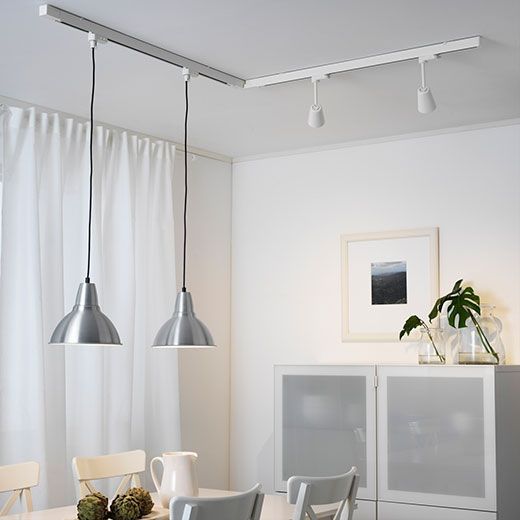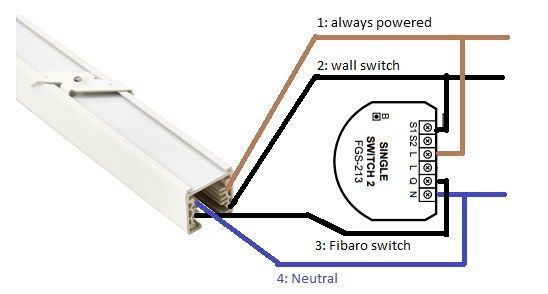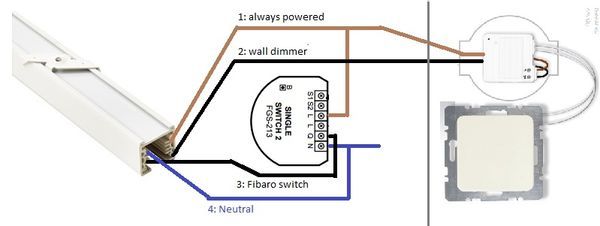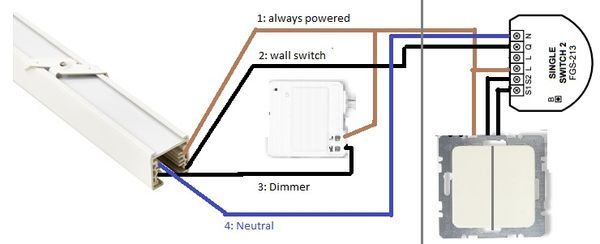This is the forum archive of Homey. For more information about Homey, visit the Official Homey website.
The Homey Community has been moved to https://community.athom.com.
This forum is now read-only for archive purposes.
The Homey Community has been moved to https://community.athom.com.
This forum is now read-only for archive purposes.
How-to: A heterogeneous smart home with Ikea Skeninge rail system
 JaapPelt
Member
JaapPelt
Member
I like to make my rooms dynamic by having various zones of dimmed lights, spotlights, a bit of color and the main lighting. No matter how much I plan in advance, I used to change devices and wiring relatively frequently. When I discovered that the Ikea rail system had 3 different groups, I decided to try it out. The initial result was so positive that I decided to share my experience.
The Skeninge rail system from Ikea is exceptionally well suited to get started with your smart home. The rail system has 3 "power groups". Each individual lamp connected to the rail can be set to one of these groups using a switch in the side of the lamp-connector. This allows you to combine dumb lamps with smart lamps, dimmable with undimmable and allow you to switch different zones individually.

Source: Ikea.nl
Many of us began with Philips Hue as the first step towards a smart home. As you know, Hue lamps need to be "always on" to allow them to be controlled remotely. By having multiple groups, you can have an "always on" group just for your hue lamps while your other lamps still work with the light switch.
Fibaro and KaKu both have devices which can be placed in between the switch and light and will always turn the light on or off when the switch is flipped. This allows for 100% reliability by not relying on a wireless protocol or Homey. I strongly recommend to have the main light in each room in such a 100% reliable setup.
In addition, these in-between devices work well with an existing hotel-switch (two switches controlling one light).
Basic setup
For the hallway, I choose the following channels:

I particularly liked how efficient the wiring was. It ensured everything fitted in the ceiling pretty easily. You could argue that because it's all in the ceiling, this would be allowed in a rented home because you don't touch the switches.
The dumb wall switch group is nice to have for additional reliability, but the Fibaro group should completely replace it in the near future. I can recommend to use the fibaro double switch as it allows you have one hue channel and two independently switchable channels for more flexibility.
Advanced setup
For the living room, I'd like to have a dimmable, non-dimmable and hue channel to allow for more diverse scenes using non-dimmable spotlights, dimmable leds and Hue lamps for color.
Option 1:
The diagram below shows the Kaku receiver behind the wall switch. The disadvantage is that it Kaku is a receiver only, so it cannot send a signal when it is switched on or off.

Option 2:
By using a Fibaro device behind the wall switch, the switch both send and receive signals and thus control the other channels via Homey for a more seamless experience. Alternatively, a double wall switch could be used to control the hue lamps using the second switch via Homey.

Conclusion:
I was surprised that an relatively simple Ikea system would be so well suited for smart homes. The different groups of the rail system allows the combination of older and newer devices seamlessly. You can swap out light bulbs for dimmable, non-dimmable or Hue lights without needing to rewire everything.
It is a great way to play around with the lights in your house and step by step upgrade your lamps and Homey flows. The main drawback is that it is not a very refined system. It is a bit bulky, the gap in the middle is not very pretty and it requires a hammer to help with the tight fits.
If you are moving or if you want to upgrade your lighting, I can recommend this, or other group system. I know there are more rail systems with groups, but they can be hard to find as they are not well advertised. Ikea is always a budget contentious choice and easy to get your hands on. The possibility to play around with your lights and scenes using various types of lamps is great to have.
The Skeninge rail system from Ikea is exceptionally well suited to get started with your smart home. The rail system has 3 "power groups". Each individual lamp connected to the rail can be set to one of these groups using a switch in the side of the lamp-connector. This allows you to combine dumb lamps with smart lamps, dimmable with undimmable and allow you to switch different zones individually.

Source: Ikea.nl
Many of us began with Philips Hue as the first step towards a smart home. As you know, Hue lamps need to be "always on" to allow them to be controlled remotely. By having multiple groups, you can have an "always on" group just for your hue lamps while your other lamps still work with the light switch.
Fibaro and KaKu both have devices which can be placed in between the switch and light and will always turn the light on or off when the switch is flipped. This allows for 100% reliability by not relying on a wireless protocol or Homey. I strongly recommend to have the main light in each room in such a 100% reliable setup.
In addition, these in-between devices work well with an existing hotel-switch (two switches controlling one light).
Basic setup
For the hallway, I choose the following channels:
- Always on (hue)
- dumb wall switch
- Fibaro switch.

I particularly liked how efficient the wiring was. It ensured everything fitted in the ceiling pretty easily. You could argue that because it's all in the ceiling, this would be allowed in a rented home because you don't touch the switches.
The dumb wall switch group is nice to have for additional reliability, but the Fibaro group should completely replace it in the near future. I can recommend to use the fibaro double switch as it allows you have one hue channel and two independently switchable channels for more flexibility.
Advanced setup
For the living room, I'd like to have a dimmable, non-dimmable and hue channel to allow for more diverse scenes using non-dimmable spotlights, dimmable leds and Hue lamps for color.
- Always on (hue)
- dimmable
- non-dimmable
Option 1:
The diagram below shows the Kaku receiver behind the wall switch. The disadvantage is that it Kaku is a receiver only, so it cannot send a signal when it is switched on or off.

Option 2:
By using a Fibaro device behind the wall switch, the switch both send and receive signals and thus control the other channels via Homey for a more seamless experience. Alternatively, a double wall switch could be used to control the hue lamps using the second switch via Homey.

Conclusion:
I was surprised that an relatively simple Ikea system would be so well suited for smart homes. The different groups of the rail system allows the combination of older and newer devices seamlessly. You can swap out light bulbs for dimmable, non-dimmable or Hue lights without needing to rewire everything.
It is a great way to play around with the lights in your house and step by step upgrade your lamps and Homey flows. The main drawback is that it is not a very refined system. It is a bit bulky, the gap in the middle is not very pretty and it requires a hammer to help with the tight fits.
If you are moving or if you want to upgrade your lighting, I can recommend this, or other group system. I know there are more rail systems with groups, but they can be hard to find as they are not well advertised. Ikea is always a budget contentious choice and easy to get your hands on. The possibility to play around with your lights and scenes using various types of lamps is great to have.
Comments
Thank you for your extensive and very useful how-to! Considering implementing something similar now. How would you judge the looks of the (rather bulky) rail on your ceiling? Have you mounted more than one rail?
Thanks,
Tom
I have 3 meters with a T junction in he middle. The biggest drawback is that there is no cover for the gap in the middle. This makes the rails slightly more noticable. You should take care to align the rails with the natural lines of the room.
The bulkeness can be reduced by directly screwing the rails to the ceiling rather then using the quick release clamps. The will create a tighter fit, but it becomes even more important to perfectly align the holes to avoid gaps between the segments. My ceiling is not perfectly flat, so I had to use the clamps.
Overall, I like the looks in my modestly industrial decor. The pictures in the Ikea catalog give a pretty good impression.
I would still recommend to have a look at the demo setup in the store to see if you like it.
You can't beat the Ikea budget, but if you have the money to spend, you might find similar systems with a more refined finish at a lamp specialist.
Regards,
Tom